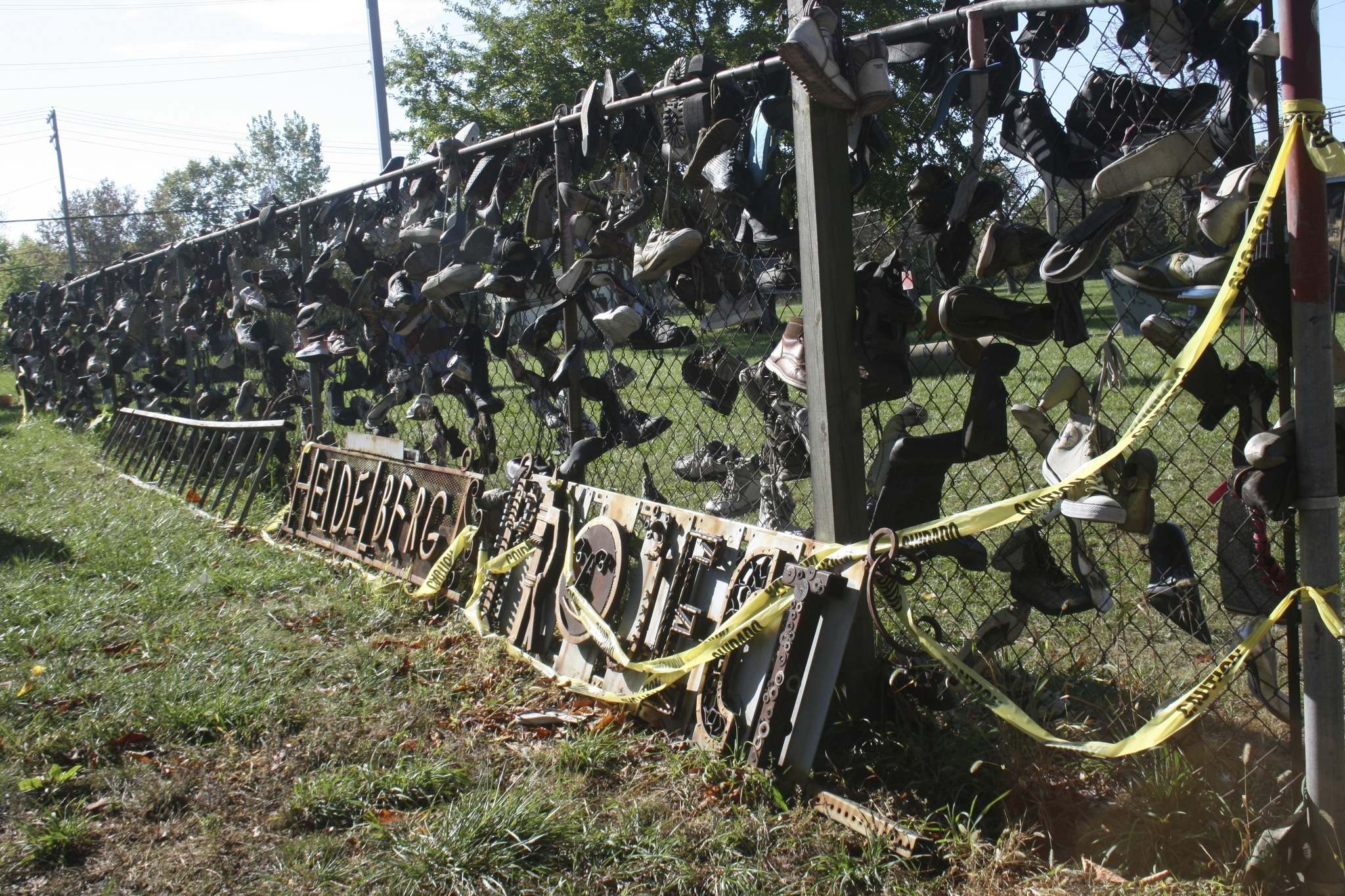Motorless in Motor City from the Winnipeg Free Press
Motorless in Motor City
Switching up the power source on a jam-packed, whirlwind tour of Detroit
by Leesa Dahl
3/24/18
In less than a week I’ve taken in all the automotive history this revitalized town has to offer. By Day 4, I’m more than fired up about a pedal-powered tour through Motor City.
My three-hour "Near East Side" bike tour kicks off at Detroit’s busy, charming riverfront area, a nine-kilometre stretch along the navigable Detroit River.
I can see the shoreline of Canada from Wheelhouse Detroit, an open-air bicycle retail and service centre that’s owned and operated by tour guide Kelli Kavanaugh, an avid cyclist and longtime Detroiter, who opened for business in 2008.
Kavanaugh, 41, offers a variety of bicycle tours of old neighbourhoods in the former American powerhouse of automotive industry, a city that is currently undergoing a resurgence after the federal government bailed out the bankrupt city in 2013. Since then, city planners and investors here have been working to restore its lost prosperity. So far, they’ve managed to build a multimillion-dollar, state-of-the-art multi-purpose arena — Little Caesars Arena — in the downtown core, repurposed hundreds of vacant buildings, skyscrapers and warehouses, and constructed a 5.3-kilometre people-mover called the Qline.
And to my delight, they’ve also put a fair share of cash into creating a safe, cycle-friendly infrastructure that Kavanaugh says is a benefit to both local commuters and visitors.
"There are currently over 200 miles (322 kilometres) of bike lanes, and we’re starting to see more protected, or buffered, lanes going in," says Kavanaugh, as she patiently fits our nine-member tour group with helmets and adequate bicycles.
Mine, a pink single-speed coaster with a lightweight aluminum frame, cosy couch saddle and a front basket is chosen for me by the store’s cautious and efficient assistant, Tony Ruacho, whose real job as "sweeper" is to keep the nine of us in unison and upright. He is also required to take care of any mechanical issues that might arise on the tour; but in reality, the cajoling Ruacho’s easy banter and keen knowledge of Detroit’s fascinating neighbourhoods are where his true talents lie.
Following Kavanaugh’s brief monologue on the importance of using hand signals — an ostensible rule of the road which should not, in any event, be diminished — we’re heading west along the gorgeous, revitalized riverwalk.
Here, we carefully weave through hundreds of costumed runners who, it would appear, are participating in a fundraising event, possibly a 5-km charity race.
It’s an easy pace for a veteran cyclist who spends a good part of her Manitoba summers pedalling to and from the newspaper’s office, an 11-km one-way trip along quiet residential streets and scenic parks. But all this clambering up and down curbs, manoeuvring between parked vehicles and pedalling up and down bridges along St. Aubin Street is arduous, so when we finally park our two-wheelers in front of a graffiti-tagged warehouse at the 43-acre Eastern Market I’m quietly relieved.
We scatter ourselves among the crowds for a quick walk-about of the historic commercial district that, on this day, is reeling with activity as thousands of Detroiters (45,000 people regularly frequent the Eastern Market on any given Saturday) eagerly try to get their hands on a wide variety of produce, meats and spices.
The scores of retail shops, restaurants and art galleries are all so alluring but we’re soon back on the saddle heading toward the market’s eastern edge. After a few minutes, we arrive at Gratiot Avenue and coast down an entrance ramp onto the Dequindre Cut Greenway, a former Grand Trunk railway line that stretches 9 km between Mack Avenue and Atwater Street.
Grafitti by local artists Hygienic Dress League is displayed along the revitalized Dequindre Cut Greenway. Photo by Leesa Dahl
Rail service here culminated in 1995, and a decade later a 20-foot-wide, two-way paved path (one for cyclists, one for pedestrians) was constructed eight metres below street level at a cost of US$21 million. The lengthy revitalization project, which is bounded by walls of grass, shrubs and a few crumbling factories, offers access to and from many residential areas. Once inside, a number of emergency poles equipped with telephones keep visitors feeling secure while they stroll, cycle or enjoy a workout on a small outdoor gym.
The Cut is a peaceful urban escape that also features some of the city’s finest graffiti, a nice touch that fills the extended green space with an urban gritty vibe.
Tagging public spaces was once an integral part of Detroit’s historical landscape. Graffiti was, and still is, a socio-political statement as well as a form of self-expression during the city’s difficult economic downturn. Here, on the Dequindre Cut Greenway, the wall art is a vibrant blend of old, fortified and new. Many are inspirational words of wisdom or simply whimsical, colourful illustrations. Others, meanwhile, are masterpieces created by some of the city’s finest graffiti artists, including Hygienic Dress League, a husband and wife team — visual artists Steve and Dorota Coy — who decorate the Cut and the rest of Detroit with their profound, inspiring works of art.
Marc Pasco, director of communications for the Detroit Riverfront Conservancy, says he is overjoyed to see Detroit bouncing back with innovative ideas like the Dequindre Cut Greenway. He "did the auto thing" for years before the flourishing industry collapsed, taking with it more than half of the city’s population.
Since then, low startup costs and economic development initiatives have created an influx of American suburbanites and millennials, who arrive daily to start up IT businesses or work for trendy companies like Shinola, a watch assembly plant located within the historic Argonaut Building, formerly the General Motors Research Laboratory. (Shinola also assembles a line of shiny, high-end bicycles at its spiffy flagship retail store on Canfield Street.)
A fence on Heidelberg Street is covered in old, worn shoes. Photo by Leesa Dahl
They live in many of the city’s old repurposed buildings such as the low rise Wayne County Building on Randolph Street in the financial district — formerly the Wayne County administrative offices — or opt to pay US$700 a month to reside in a 290-square-foot micro-apartment inside the 38-storey David Stott Building on Griswold Street.
Or, they might choose to rent one of the 279 units available at the newly developed Orleans Landing here on the Dequindre Cut Greenway.
"For US$1,000 a month you can live in a one-bedroom or for US$2,800 you can have three bedrooms," explains Pasco, who is optimistic about the recent rise in Detroit’s population (now around 700,000), the decrease in unemployment rates and a downtown core that is 99 per cent full.
With that in mind, one might be inclined to compare the city’s current economy with that of 1955, an era when Detroit was reaping the benefits of a prosperous automotive manufacturing industry. But Pasco says this is unreasonable.
"The ‘50s are gone," he says. "So let’s move on and reinvent ourselves, continue with the path we’re on, the trajectory that we’re on and create a new glory era, or a golden age, if you will."
For now, our two-wheeling trail is restricting us to the right side of a busy two-lane roadway as we say farewell to the quietness and safety of the Dequindre Cut Greenway and pass into the gentrified McDougall-Hunt neighbourhood on the city’s east side. We cautiously veer right past empty grassy lots, ramshackle buildings and abandoned homes and find ourselves at a bizarre outdoor exhibit by Detroit’s Tyree Guyton (tyreeguyton.com), a local painter and sculptor who developed his idiosyncratic environment as a creative response to ongoing blight and decay in the neighbourhood he grew up in.
A stroll down Heidelberg Street, which attracts more than 200,000 tourists a year, is like walking into an open-air art gallery that is sullied and has no decorum. It’s kind of like a neighbourhood garage sale gone astray. A leaning wire fence at its entrance is covered in hundreds of previously worn shoes (clearly a sentiment to the area’s lost souls) and the modest, clapboard homes along its length are painted in a splendour of colourful numbers and dots. Thousands of used, tattered items — doors, clocks, tires, appliances, furniture, clothes, televisions — are scattered on its sidewalks and boulevards, communicating subliminal messages of time spent and wasted.
The Heidelberg Project is said to be a powerful symbol of how a few communities in this recovering metropolis have ended up discarded. A post on the project’s Facebook page alongside an image of discarded television sets says: "Art can be a catalyst for positive change and help breathe new life into neighbourhoods that have been virtually forgotten."
It’s a hopeful way of thinking that might sadly be set aside in the next couple of years when the Heidelberg Project in McDougall-Hunt is dismantled and laid to rest, not unlike the fallen Civil War generals and other dead Detroiters who are buried at our next stop, the park-like Elmwood Cemetery, on the city’s east side.
Built in 1841, the 86-acre Elmwood Cemetery on Elmwood Avenue is a tranquil must-see stop, especially at a steady pace on a two-wheeler, which allows time to chat and learn about the history of this fascinating place.
Formerly farmland situated on the outskirts of Detroit, the tranquil non-denominational Elmwood Cemetery is presently a woodland of over 1,400 trees that represent more than 90 species. Kavanaugh says regular pruning of the black locusts, hawthorn, beech, willow, ash, American plum, domestic pear and other woody plants helps conserve the natural beauty of the grounds, which is splendidly enhanced by hundreds of statues and limestone monuments like the Gothic Revival chapel, constructed in 1856, and the Gothic-inspired gatehouse, built in 1876.
Recently, the cemetery, which also happens to be the final resting place of some of Detroit’s most distinguished people, became the city’s first accredited arboretum, a botanical garden of sorts that is similar to our final destination.
As we zip past Earthworks Urban Farm, an urban agricultural site on Meldrum Street in the near east side neighbourhood, Kavanaugh is quick to point out that it’s only one of 1,400 urban gardens and farms found in and around the city that sprouted from swathes of vacant land.
Kim Rusinow, owner and operator of Destination Detroit Tours, adds that the city’s increasing economic challenges and declining population also compelled community developers to begin to think critically and collaboratively on ways to address the abundance of vacant land.
"We viewed vacant land as an opportunity, not further demise," says Rusinow, who offers extensive tours of Detroit, including Downtown, Midtown, Eastern Market, Greektown, Corktown and the riverfront, as well as special places like the Heidelberg Project and Grand River. "We brought a better understanding of how the vacant land repurposing might be used to better life in the communities through jobs, healthily food and sustainability and improving the overall way the community looks and feels."
And like the partially constructed Inner Circle Greenway, a 42-kilometre non-motorized loop that Kavanaugh says will be completed in the next few years, Earthworks Urban Farm will continue connecting Detroit neighbourhoods, communities and people.


